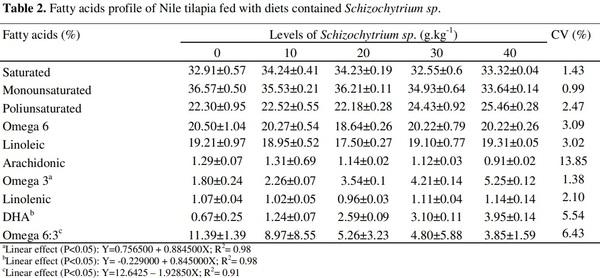Introduction
The fish nutrition has advanced with the expansion of aquaculture in order to achieve better performance rates. Thus, diets should provide all the nutrients and energy as a way to optimize the fish development. Among the nutrients, the fatty acids are essential for growth and survival, as well one of the most important sources of energy.
The fatty acids of the omega 3 family are not produced by the fish, requiring supplementation in food. It is noteworthy that the amount of omega 3 found in freshwater fish and marine are different because the staple food in both environments (algae), are equal in the amount of lipids, but different in composition. Marine and freshwater algae have approximately 50% lipids in the form of polyunsaturated fatty acids (PUFA's). However, marine algae contains higher concentrations of omega 3 than freshwater algae, which has highest concentration of omega 6. Therefore the level of omega-3 PUFA's family in freshwater fish is low in relation to marine water fish (RIBEIRO et al., 2007).
As the body lipid profile can be changed according to diet, the inclusion of omega-3 sources, such as docosahexaenoic acid (DHA), may increase the levels of this fatty acid in the fish body (Elias, 2014). Thus, the inclusion of marine algae in diets for freshwater fish may have intended to improve performance and increase the DHA level in its meat, improving the nutritional value of the product.
Among the algae consumed by fish saltwater, the Schizochytrium sp. has favorable nutritional characteristics to introduce in fish diets because It has in its composition approximately 25% of DHA. Thus, the body composition of Nile tilapia juveniles fed with the algae Schizochytrium sp. was studied.
Materials and Methods
The trial was conducted at the Laboratory of Aquaculture and Aquatic Ecology of Animal Science Department, Federal University of Vales do Jequitinhonha e Mucuri, Diamantina - MG.
We used 240 Nile tilapias distributed in a completely randomized design, with five treatments, four replicates and five fish per tank. The trial was conducted in recirculation system containing 35L tanks, individual and constant aeration, temperature-controlled, biofiltration and filter ultraviolet (UV). Three times a week, the tanks were cleaned by siphoning. Once a week the water quality parameters were measured, as follows: temperature, pH, dissolved oxygen and ammonia.
Fish were fed with five diets contained the same nutritional composition (90% DM, 32% CP, 3100kcal DE, 3.91% CF, 9.7% EE), being used the levels 0, 10, 20, 30 and 40 g of Schizochytrium sp.kg-1 of diet. The tilapias were fed four times a day (8:00, 11:00, 14:00 and 17:00) until the satiety, preventing food leftovers.
After 56 days the Nile tilapias were slaughtered according the principles of humanitarian described in Instruction No 3/2000. The fish carcasses were freeze-dried, ground and weighted. Part of the samples of fish and all experimental diets were forwarded to the Chemical Analysis Laboratory (DZO-UFVJM) for chemical analysis (dry matter, mineral matter, ether extract, crude protein, calcium and phosphorus). The other part was sent to the Institute of Food Technology (ITAL- Campinas) for lipid profile analysis.
The body composition data were submitted to statistical analysis using the program Statistical Analysis System 9.0 (SAS, 2008). Subsequently, the effects of the levels of Schizochytrium sp. in the diet were estimated by analysis of variance and linear regression model.
Results and Discussion
During the experimental time the recirculation system maintained the water quality within the range established by Kubitza (2000) for tropical fish. For body analysis (Table 1), the Schizochytrium sp. levels influenced the body crude protein, which presented quadratic effect (p <0.05) in function of the treatments. The inclusion of 20g of Schizochytrium sp.kg-1 increased body crude protein of fish at 9.25% compared to the control treatment. As the dry matter (DM), mineral matter (MM), calcium (Ca), ether extract (EE) and phosphorus (P), no differences were observed between the levels studied (p> 0.05).
The levels of omega 3 and DHA body were increasing in function of the inclusion of algae in the diet. The tilapias fed with 40g of Schizochytrium sp..kg-1 of diet presented 2.92 and 5.9 times more omega-3 and DHA, respectively, than those that ingested the control diet.
With the inclusion Schizochytrium sp. were observed improvement in the relationship omega 6 and omega 3. According to the Food and Agriculture Organization / World Health Organization (FAO / WHO, 2008), the ideal relationship between these fatty acids in food is 5: 1, values close to those presented when added 20g Schizochytrium sp. or more in the diet.
According to the results, the lipid profile of tilapia can be modified depending of the ingredients used in the diet composition. The different levels of inclusion of algae Schizochytrium sp. provided different lipid profiles, which can be explained by the composition of polyunsaturated fatty acids present in this algae, mainly omega 3 family.
Conclusions
It was concluded that Nile tilapia fed with diets containing 40g of Schizochytrium sp.kg-1 presents higher deposition of Omega 3 and DHA body.
Presented at the 52a Reunião Anual da Sociedade Brasileira de Zootecnia.






